















|
Then felt I like some watcher of the skies when a new planet swims into his ken. - John Keats
| Introduction |
|---|
Jupiter is the fifth planet from the Sun and is the largest one in the solar system. If Jupiter were hollow, more than one thousand Earths could fit inside. It also contains more matter than all of the other planets combined. It has a mass of 1.9 x 1027 kg and is 142,800 kilometers (88,736 miles) across the equator. Jupiter possesses 16 satellites, four of which - Callisto, Europa, Ganymede and Io - were observed by Galileo as long ago as 1610. There is a ring system, but it is very faint and is totally invisible from the Earth. (The rings were discovered in 1979 by Voyager 1.) The atmosphere is very deep, perhaps comprising the whole planet, and is somewhat like the Sun. It is composed mainly of hydrogen and helium, with small amounts of methane, ammonia, water vapor and other compounds. At great depths within Jupiter, the pressure is so great that the hydrogen atoms are broken up and the electrons are freed so that the resulting atoms consist of bare protons. This produces a state in which the hydrogen becomes metallic.
Colorful latitudinal bands, atmospheric clouds and storms illustrate Jupiter's dynamic weather systems. The cloud patterns change within hours or days. The Great Red Spot is a complex storm moving in a counter-clockwise direction. At the outer edge, material appears to rotate in four to six days; near the center, motions are small and nearly random in direction. An array of other smaller storms and eddies can be found through out the banded clouds.
Auroral emissions, similar to Earth's northern lights, were observed in the polar regions of Jupiter. The auroral emissions appear to be related to material from Io that spirals along magnetic field lines to fall into Jupiter's atmosphere. Cloud-top lightning bolts, similar to superbolts in Earth's high atmosphere, were also observed.
Unlike Saturn's intricate and complex ring patterns, Jupiter has a single ring that is almost uniform in its structure. It is probably composed of dust particles less than 10 microns in diameter -- about the size of cigarette smoke particles. It extends to an outer edge of about 129,000 kilometers (80,161 miles) from the center of the planet and inward to about 30,000 kilometers (18,642 miles). The origin of the ring is probably from micrometeorite bombardment of the tiny moons orbiting within the ring.
Jupiter's rings and moons exist within an intense radiation belt of electrons and ions trapped in the planet's magnetic field. These particles and fields comprise the jovian magnetosphere or magnetic environment, which extends 3 to 7 million kilometers (1.9 to 4.3 million miles) toward the Sun, and stretches in a windsock shape at least as far as Saturn's orbit - a distance of 750 million kilometers (466 million miles).
| Animations of Jupiter |
|---|
| Views of Jupiter |
|---|
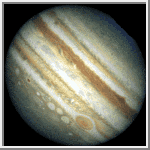 Jupiter
Jupiter
This image was taken by NASA's Hubble Space Telescope on February 13,
1995. The image provides a detailed look at a unique cluster of
three white oval-shaped storms that lie southwest (below and to the
left) of Jupiter's Great Red Spot. The appearance of the clouds, in
this image, is considerably different from their appearance only
seven months earlier. These features are moving closer
together as the Great Red Spot is carried westward by the prevailing
winds while the white ovals are swept eastward.
The outer two of the white storms formed in the late 1930s. In the
centers of these cloud systems the air is rising, carrying fresh
ammonia gas upward. New, white ice crystals form when the upwelling
gas freezes as it reaches the chilly cloud top level where temperatures
are -130°C (-200°F).
The intervening white storm center, the ropy structure to the left of
the ovals, and the small brown spot have formed in low pressure cells.
The white clouds sit above locations where gas is descending to lower,
warmer regions.
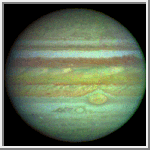 Jupiter
Jupiter
This image was taken by the Wide Field/Planetary Camera of the Hubble
Telescope. It is a true color composite of the full disk of Jupiter. All
features in this image are cloud formations in the Jovian atmosphere,
which contain small crystals of frozen ammonia and traces of colorful
compounds of carbon, sulfur and phosphorous. This photograph was
taken on May 28, 1991. (Courtesy NASA/JPL)
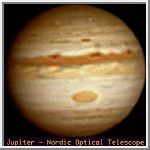 Nordic Optical Telescope
Nordic Optical Telescope
This image of Jupiter was taken with the 2.6 meter
Nordic Optical
Telescope, located at La Palma, Canary Islands. It is a good
example of the best imagery that can be obtained from earth based
telescopes.
(c) Nordic Optical Telescope Scientific Association (NOTSA).
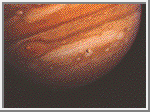 Jupiter with Satellites Io and Europa
Jupiter with Satellites Io and Europa
Voyager 1 took this photo of Jupiter
and two of its satellites (Io, left, and
Europa, right) on Feb. 13, 1979. In this view,
Io is about 350,000 kilometers (220,000 miles) above Jupiter's Great
Red Spot, while Europa is about 600,000 kilometers (373,000 miles) above
Jupiter's clouds. Jupiter is about 20 million kilometers (12.4 million
miles) from the spacecraft at the time of this photo.
There is evidence of circular motion in Jupiter's atmosphere. While the
dominant large scale motions are west-to-east, small scale
movement includes eddy like circulation within and between the
bands. (Courtesy NASA/JPL)
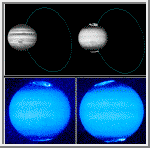 Jupiter's Auroras
Jupiter's Auroras
These HST images, reveal changes
in Jupiter's auroral emissions and how small auroral spots just
outside the emission rings are linked to the planet's volcanic
moon, Io. The top panel pinpoints the
effects of emissions from Io. The image on
the left, shows how Io and Jupiter are
linked by an invisible electrical current of charged particles
called a flux tube. The particles, ejected from Io
by volcanic eruptions, flow along
Jupiter's magnetic field lines, which thread through Io, to the
planet's north and south magnetic poles.
The top-right image shows Jupiter's auroral emissions at the north and south poles. Just outside these emissions are the auroral spots called "footprints." The spots are created when the particles in Io's "flux tube" reach Jupiter's upper atmosphere and interact with hydrogen gas, making it fluoresce.
The two ultraviolet images at the bottom of the picture show how the auroral emissions change in brightness and structure as Jupiter rotates. These false-color images also reveal how the magnetic field is offset from Jupiter's spin axis by 10 to 15 degrees. In the right image, the north auroral emission is rising over the left limb; the south auroral oval is beginning to set. The image on the left, obtained on a different date, shows a full view of the north aurora, with a strong emission inside the main auroral oval.
Credits: John T. Clarke and Gilda E. Ballester (University
of Michigan), John Trauger and Robin Evans (Jet Propulsion
Laboratory), and NASA.
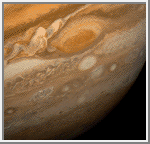 The Great Red Spot
The Great Red Spot
This dramatic view of Jupiter's Great Red Spot and its
surroundings was obtained by Voyager 1 on Feb. 25, 1979, when the
spacecraft was 9.2 million kilometers (5.7 million miles) from
Jupiter. Cloud details as small as 160 kilometers (100 miles)
across can be seen here. The colorful, wavy cloud pattern to the
left of the Red Spot is a region of extraordinarily complex and
variable wave motion. (Courtesy NASA/JPL)
 False Color of Jupiter's Great Red Spot
False Color of Jupiter's Great Red Spot
This image is a false color representation of Jupiter's Great Red Spot
taken with Galileo's imaging system through three different near-infrared
filters. This is a mosaic of eighteen images (6 in each filter) that were
taken over a period of 6 minutes on June 26, 1996. The Great Red Spot
appears pink and the surrounding region blue because of the particular
color coding used in this representation. The red channel is the
reflectance of Jupiter at a wavelength where methane strongly absorbs
(889nm). Because of this absorption, only high clouds can reflect sunlight
in this wavelength. The green channel is the reflectance in a wavelength
where methane absorbs, but less strongly (727nm). Lower clouds can reflect
sunlight in this wavelength. Finally, the blue channel is the reflectance
in a wavelength where there are essentially no absorbers in the Jovian
atmosphere (756nm) and one sees light reflected from the deepest clouds.
Thus, the color of a cloud in this image indicates its height, with red or
white being highest and blue or black being lowest. This image shows the
Great Red Spot to be relatively high, as are some smaller clouds to the
northeast and northwest that are surprisingly like towering thunderstorms
found on earth. The deepest clouds are in the collar surrounding the Great
Red Spot, and also just to the northwest of the high (bright) cloud in the
northwest corner of the image. Preliminary modelling shows these cloud
heights to range about 50km in altitude.
(Courtesy NASA/JPL)
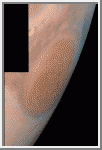 Galileo Red Spot
Galileo Red Spot
This view of Jupiter's Great Red Spot is a mosaic of two images taken
by the Galileo spacecraft. The image
was created using two filters,
violet and near-infrared, at each of two camera positions. The Great
Red Spot is a storm in Jupiter's atmosphere and is at least 300
years-old. Winds blow counterclockwise around the Great Red Spot at
about 400 kilometers per hour (250 miles per hour). The size of the
storm is more than one Earth diameter (13,000 kilometers or 8,000
miles) in the north-south direction and more than two Earth diameters
in the east-west direction. In this oblique view, where the Great Red
Spot is shown on the planet's limb, it appears longer in the
north-south direction. The image was taken on June 26, 1996.
(Courtesy NASA/JPL)
 Ring of Jupiter
Ring of Jupiter
The ring of Jupiter was discovered by Voyager 1 in March of 1979.
This image was taken by Voyager 2 and has been pseudo colored. The
Jovian ring is about 6,500 kilometers (4,000 miles) wide and probably
less than 10 kilometers (6.2 miles) thick.
(Credit: Calvin J. Hamilton)
 Equator of Jupiter
Equator of Jupiter
This image shows the entire equatorial region of Jupiter. It was created
from a mosaic of several images. The Great Red Spot is
toward the left of the image.
(Credit: Calvin J. Hamilton, and NASA)
 Moons of Jupiter
Moons of Jupiter
This image shows to scale Jupiter's moons
Amalthea, Io,
Europa, Ganymede,
and Callisto.
(Credit: Calvin J. Hamilton)
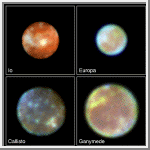 Hubble Photo Gallery of the Galilean Satellites
Hubble Photo Gallery of the Galilean Satellites
This is a Hubble Space Telescope family portrait of the four
largest moons of Jupiter, first observed by the Italian scientist
Galileo Galilei
nearly four centuries ago. Located approximately one-half
billion miles away, the moons are so small that, in visible light, they
appear as fuzzy disks in the largest ground-based telescopes. Hubble
can resolve surface details seen previously only by the Voyager
spacecraft in the early 1980's.
Hubble has charted new volcanic activity on Io's
active surface, found a faint oxygen atmosphere on the moon
Europa, and identified ozone on the surface
of Ganymede. Hubble ultraviolet
observations of Callisto show the presence
of fresh ice on the surface that may indicate impacts from
micrometeorites and charged particles from Jupiter's magnetosphere.
(Credit: STScI/NASA)
| Rings of Jupiter |
|---|
| Name | Distance* | Width | Thickness | Mass | Albedo |
|---|---|---|---|---|---|
| Halo | 100,000 km | 22,800 km | 20,000 km | ? | 0.05 |
| Main | 122,800 km | 6,400 km | < 30 km | 1 x 10^13 kg | 0.05 |
| Gossamer | 129,200 km | 850,000 km | ? | ? | 0.05 |
*The distance is measured from the planet center to the start of the ring.
| Jupiter's Moon Summary |
|---|
Nearly four centuries ago Galileo Galilei turned his homemade telescope towards the heavens and discovered three points of light, which at first he thought to be stars, hugging the planet Jupiter. These stars were arranged in a straight line with Jupiter. Sparking his interest, Galileo observed the stars and found that they moved the wrong way. Four days later another star appeared. After observing the stars over the next few weeks, Galileo concluded that they were not stars but planetary bodies in orbit around Jupiter. These four stars have come to be know as the Galilean satellites.
Over the course of the following centuries another 12 moons were discovered bringing the total to 16. Finally in 1979, the strangeness of these frozen new worlds was brought to light by the Voyager spacecrafts as they swept past the Jovian system. Again in 1996, the exploration of these worlds took a large step forward as the Galileo spacecraft began its long term mission of observing Jupiter and its moons.
Twelve of Jupiter's moons are relatively small and seem to have been more likely captured than to have been formed in orbit around Jupiter. The four large Galilean moons, Io, Europa, Ganymede and Callisto, are believed to have accreted as part of the process by which Jupiter itself formed. The following table summarizes the radius, mass, distance from the planet center, discoverer and the date of discovery of each of the moons of Jupiter:
| Moon | # | Radius (km) | Mass (kg) | Distance (km) | Discoverer | Date |
|---|---|---|---|---|---|---|
| Metis | XVI | 20 | 9.56e+16 | 127,969 | S. Synnott | 1979 |
| Adrastea | XV | 12.5x10x7.5 | 1.91e+16 | 128,971 | Jewitt-Danielson | 1979 |
| Amalthea | V | 135x84x75 | 7.17e+18 | 181,300 | E. Barnard | 1892 |
| Thebe | XIV | 55x45 | 7.77e+17 | 221,895 | S. Synnott | 1979 |
| Io | I | 1,815 | 8.94e+22 | 421,600 | Marius-Galileo | 1610 |
| Europa | II | 1,569 | 4.80e+22 | 670,900 | Marius-Galileo | 1610 |
| Ganymede | III | 2,631 | 1.48e+23 | 1,070,000 | Marius-Galileo | 1610 |
| Callisto | IV | 2,400 | 1.08e+23 | 1,883,000 | Marius-Galileo | 1610 |
| Leda | XIII | 8 | 5.68e+15 | 11,094,000 | C. Kowal | 1974 |
| Himalia | VI | 93 | 9.56e+18 | 11,480,000 | C. Perrine | 1904 |
| Lysithea | X | 18 | 7.77e+16 | 11,720,000 | S. Nicholson | 1938 |
| Elara | VII | 38 | 7.77e+17 | 11,737,000 | C. Perrine | 1905 |
| Ananke | XII | 15 | 3.82e+16 | 21,200,000 | S. Nicholson | 1951 |
| Carme | XI | 20 | 9.56e+16 | 22,600,000 | S. Nicholson | 1938 |
| Pasiphae | VIII | 25 | 1.91e+17 | 23,500,000 | P. Melotte | 1908 |
| Sinope | IX | 18 | 7.77e+16 | 23,700,000 | S. Nicholson | 1914 |

 Return to Mars
Return to Mars
 Voyage to Saturn
Voyage to Saturn
